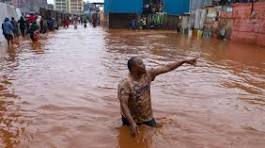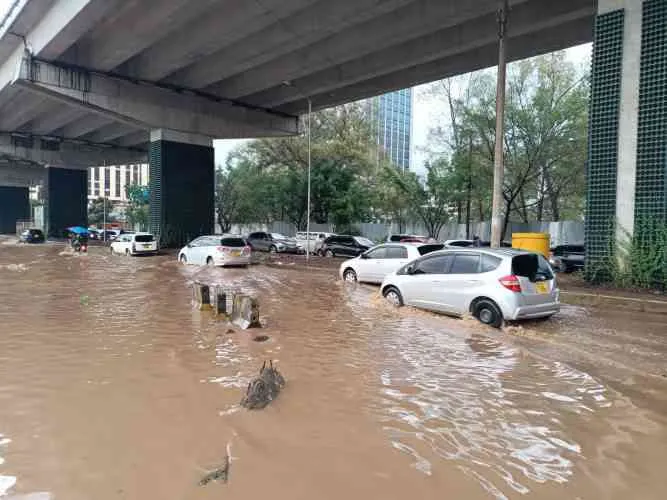By Bradley Shahenza
Nairobi — Heavy rains once again plunged sections of Nairobi into chaos this week, flooding expressways, national roads, and key residential areas. Motorists were stranded, traffic snarled, and many questioned why the county government’s long-promised clean-up supposedly to start in August, is still not evident in many flood-prone zones.For more stories on climate and environment, visit our Environment section.

Floods Paralyze City Life
For residents, the experience has become painfully familiar. Each rainy season brings chaos to neighborhoods like South C, Umoja, Kayole, and Mathare, where roads turn into rivers and homes are inundated. Vehicles stall in flooded streets, pedestrians wade through dirty water, and businesses are forced to close, costing millions in damages and lost income.
In the Central Business District, traffic grinds to a halt whenever rain falls heavily. Commuters are left stranded as matatus refuse to enter flooded roads, while traders struggle to save their goods from rising waters. “We are tired of the same story every year,” says Grace Wanjiru, a shopkeeper along Racecourse Road. “The county keeps saying they are cleaning the drains, but look — nothing has changed.”
A Cleanup Promise Unfulfilled
In 2024, Governor Johnson Sakaja launched an ambitious citywide cleanup initiative meant to unclog Nairobi’s drainage systems, improve garbage collection, and prevent flooding. The campaign, carried out in partnership with the National Youth Service (NYS) and local community groups, was welcomed by residents as a long-awaited solution.
At the launch, Governor Sakaja vowed that “no Nairobi resident should lose property or life to preventable floods.” However, the recent deluge has exposed glaring gaps between promises and reality. Piles of garbage still line major roads, drainage trenches remain blocked, and uncollected waste continues to find its way into rivers and sewers.
Environmental activists and urban planners now question whether the county’s efforts were more cosmetic than structural. James Mwangi, a civil engineer and environmental consultant, says the city’s drainage design is outdated. “Most of Nairobi’s drainage was built during the colonial era for a much smaller population,” he explains. “Today, the infrastructure simply cannot handle the amount of runoff and waste generated by over four million residents.”Read also: Nairobi County’s Past Promises on Urban Management
Garbage and Urban Planning Failures
The city’s waste management problem lies at the heart of the flooding crisis. Poor disposal habits, illegal dumping, and irregular garbage collection combine to block storm drains, especially in densely populated informal settlements. Plastic waste, in particular, has become a menace that chokes waterways and prevents water from flowing freely.
Nairobi River, once a vital lifeline for the city, has turned into a dumping ground for household and industrial waste. Whenever it rains, the river overflows, flooding nearby communities in Mathare, Mukuru, and Kariobangi. Residents often blame county workers for failing to maintain drainage systems, while county officials cite limited resources and public indiscipline as key obstacles.
Urban planners argue that encroachment on floodplains and unregulated construction have worsened the situation. “Buildings have been erected on natural water paths,” notes Mwangi. “Even the best drainage system cannot function if rivers and channels are blocked by development.”Related: How Poor Waste Disposal Worsens Nairobi’s Floods
The Human Cost of Flooding
Beyond infrastructure damage, the floods have had devastating human impacts. Families living in low-lying areas lose homes and belongings to rising waters. Some have been forced to seek temporary shelter in schools or churches. Children risk contracting waterborne diseases such as cholera and typhoid due to contamination from overflowing sewage lines.
The Nairobi County Disaster Management Unit reported multiple rescue operations in early October, assisting residents trapped in flooded estates. However, residents claim that the response is often slow and uncoordinated. “We feel abandoned,” says Peter Otieno from Kayole. “We only see officials after the floods have destroyed everything.”
What Needs to Be Done
Experts agree that solving Nairobi’s flood problem requires long-term, coordinated action — not seasonal cleanups. This includes modernizing the drainage network, enforcing waste disposal laws, and relocating settlements from high-risk flood zones. The county also needs to strengthen partnerships with environmental organizations and community groups to promote proper waste management and recycling.
Public education is key as well. Many residents still dispose of garbage into open drains, unaware of the consequences. Creating awareness and providing accessible waste collection points could go a long way in reducing blockages.
Transparency and accountability in county projects are equally crucial. Residents are demanding regular progress updates on cleanup budgets and implementation timelines. Without openness, trust in government promises will continue to erode.Check out Kenya’s Infrastructure Projects for more on how cities can adapt to climate change.Anchor text
Conclusion
The persistent floods in Nairobi are not just a product of heavy rains but a symptom of deeper governance and planning failures. While the county’s cleanup pledge raised hope, the current situation paints a different picture — one of unfulfilled commitments and systemic neglect. Unless the Nairobi County Government shifts from promises to practical action, the capital will remain trapped in a recurring cycle of floods, damage
For now, residents can only brace themselves for the next storm, hoping that this time, their cries for lasting solutions will finally be heard.
Read our detailed report on Nairobi’s waste management crisis and how it fuels flooding.


















